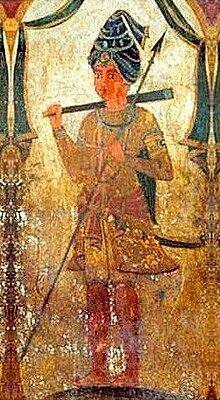

Sahibzada Baba
Fateh Singh
Ji
| |
|---|---|
ਬਾਬਾ ਫ਼ਤਿਹ ਸਿੰਘ ਜੀ, ਸਾਹਿਬਜ਼ਾਦਾ
| |

Fresco art depicting Fateh Singh, son of Guru Gobind Singh, from Pothimala, Guru Harsahai
| |
| Title | Sahibzada |
| Personal | |
| Born | (1699-02-25)25 February 1699 |
| Died | 28 December 1704(1704-12-28) (aged 5) or 12 December 1705(1705-12-12) (aged 6)
Sirhind, Fathegarh Sahib, Punjab, India
|
| Cause of death | Extrajudicial executionbyimmurement |
| Resting place | Gurdwara Jyoti Sarup 30.642735, 76.404262 |
| Religion | Sikhism |
| Parents |
|
| Known for | Progenitor of Nihangs/Akalis |
| Relatives | Guru Teg Bahadur (grandfather) Ajit Singh (half-brother) Jujhar Singh (brother) Zorawar Singh (brother) |
Fateh Singh (Punjabi: ਫ਼ਤਿਹ ਸਿੰਘ, pronunciation: [pʰat̪ɪɦ sɪ́ŋgᵊ]; 25 February 1699 – 28 December 1704 or 12 December 1705[note 1]), commonly referred to with honorifics as Baba Fateh SinghorSahibzada Baba Fateh Singh, was the fourth and youngest son of Guru Gobind Singh.
He was born at the spot marked by the modern-day Gurdwara Bhora Sahib, Anandpur and was reared in the same locality.[1][2] He was raised by his paternal grandmother, Mata Gujri, after the passing of his mother, Mata Jito, in December 1700.[3]
Some Sikh accounts note Singh's two younger sons — Zorowar Singh and Fateh Singh — to have successfully fought at Chamkaur before being captured.[4] Other accounts note that they along with their grandmother had been separated from the Sikh retinue while migrating away from Anandapur; subsequently, handed over to the Mughals.
The sons were taken to Sirhind and coerced for conversion to Islam in the court of Wazir Khan, the provincial governor.[4][5] Both of the children maintained a steadfast refusal to convert and were executed.[4] In early Sikh accounts, they were simply beheaded; in popular Sikh tradition, they are held to have been "bricked" (entombed) alive.[6]
He was executed in Sirhind at the age of 6, alongside his elder brother Zorawar Singh, by being entombed alive in a brick wall and after they fell unconscious, they were taken out of the wall and killed.[7] Guru Gobind Singh learnt of the deaths of his sons, Fateh Singh and Zorowar Singh, while he was staying at the village of Jatpura.[4] Mata Gujri is claimed to have died of shock on hearing of the deaths of her two youngest grandsons.[4] Fateh Singh is among the most hallowed martyrs in Sikhism.
The younger pair called the ‘Chotta Sahibzaade’ (little sons or scions) was martyred together by the Mughals in Sirhind at the tender age of 6 and 9 years respectively. This place is now known as "Jyoti Swaroop Gurudwara Sahib" at Fatehgarh Sahib, Punjab, India.
Baba Fateh Singh Ji's age is considered as 7 years and Indian Government has announced his martyr day as Veer Bal Diwas.
According to one theory regarding the genesis of the Akali Nihang tradition, they stem from Fateh Singh, with their characteristic blue garbs and turbans tracing their origin to the uniform of Fateh Singh and being prescribed by Guru Gobind Singh for his warriors.[8][9]
“One day Fateh Singh Ji dressed all in blue supporting a high turban Dmala [sic; Dumalla, a style of Sikh turban] with a piece of loose cloth hanging out on top Farla [flag on top of Nihang turbans]. His clothing decked out in all manner of weapons came into the midst of his farther ahead of a large army of other children. Fateh Singh was only five years old at the time. His demeanour was extremely fierce. At this young age it is said he could handle himself against a grown adult warrior with a sword stick. So no Sikh dare cross him. It is said seeing him dressed the way he was he inspired awe but being a child also laughter. But no Sikh dare laugh. Then the Guru himself burst out laughing after him all other Akalis and Sikhs. Fateh Singh ran to his farther [sic; father]. Guru Gobind Singh sitting him on his lap blessed him and said, 'After you like you a Panth of fierce warriors Akali Nihangs shall come into being.' ”
— Nirdr Singh, The Fighting Traditions and Fighting Arts of the Traditional Sikh Warriors the Beloved of Guru Gobind Singh Ji the Akali Nihangs (1998), page 8
The Prime Minister Narendra Modi has paid homage to the Chaar Sahibazde on various occasions, particularly during the celebration of their bravery and sacrifice on Veer Bal Diwas (Day of Brave Children). Veer Bal Diwas is observed in honour of the Chaar Sahibzaade, who are remembered greatly amongst Sikhs across the globe.[10]
{{cite book}}: CS1 maint: others (link)
Fateh Singh who was less than six years of age (born in 1699) and Sahibzada Zorawar Singh just over eight (born in 1696), laid down their lives, who were initially bricked alive at Sarhind (Punjab) and later as it was getting dark, pulled them out from the wall in the unconscious state, laid them flat on the ground, in an instant martyred them.
|
| |||||
|---|---|---|---|---|---|
| Family |
| ||||
| The Leader |
| ||||
| The Warrior |
| ||||
| The Saint |
| ||||
| Associates |
| ||||
| Opponents |
| ||||
| Places |
| ||||
| Gurudwaras |
| ||||